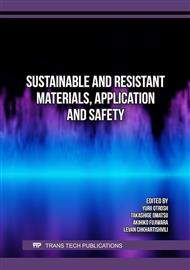p.3
p.9
p.15
p.23
p.33
p.41
p.49
p.61
Influence of Relative Humidity on the Expansion Coefficient Rate of Bamboo Bundles
Abstract:
Relative humidity (RH) can have a significant impact on bamboo products, leading to issues such as swelling, shrinking, and even cracking. Unfortunately, these effects are often difficult to detect in bamboo bundles. This research aims to investigate how RH affects the moisture expansion coefficient (β) of bamboo bundles. Samples from the stem of the Dendrocalamus genus were dried in an oven at 105 °C until they reached a stable weight. The samples were then hand-pulled and cut to create cross-sections with areas ranging from 0.06 mm2 to 0.09 mm2 and a length of 60 mm. The expansion coefficient of the bamboo bundles was measured using a tensile test, following the ASTM D3379 standard. This was conducted at a constant temperature of 27 °C and a force of 10 N in a controlled chamber with RH levels between 50% and 85% for a full day, with five replicates for accuracy. The results indicate that the strain in bamboo bundles is influenced by both relative humidity (RH) and tensile load. When the RH ranges from 85% to 50%, the bamboo bundles tend to stretch under tensile load. However, when the RH drops to 50% without tensile load, the bundles can return to their original shape. This suggests that while the initial changes in strain may be small, bamboo bundles gradually experience increased strain over time, and prolonged use could result in more significant alterations. Another important factor to consider when using bamboo bundles is the effect of changes in relative humidity (ΔRH) on the average value of β. Indeed, bamboo bundles need time to absorb or release moisture as the surrounding environment changes. The average value of β tends to decrease dramatically in an exponential decay pattern. When ΔRH exceeds 5% in both charge and discharge conditions, the average value of β can be considered equal and constant, as it becomes extremely small and negligible. However, at ΔRH levels higher than 20%, the average value of β converges to 1.5 x 10-4 (%RH)-1, indicating that the bamboo bundles have already adapted to the surrounding humidity. Therefore, it is crucial to carefully assess application areas with rapid humidity fluctuations when using bamboo bundles to prevent potential damage during use.
Info:
Periodical:
Pages:
3-8
Citation:
Online since:
October 2025
Keywords:
Price:
Сopyright:
© 2025 Trans Tech Publications Ltd. All Rights Reserved
Share:
Citation:


